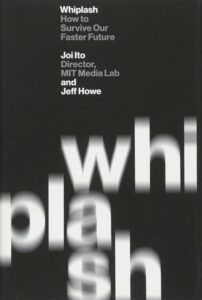 Talking about the rate of change in our society has transcended being a statement of fact to being something of a cliché. Never the less, technical and societal changes are forcing us to regularly ask deep questions about how to move forward in the midst of rapid change. Joi Ito and Jeff Howe of the MIT Media Lab tackle these questions and propose new guiding principles in their book Whiplash.
Talking about the rate of change in our society has transcended being a statement of fact to being something of a cliché. Never the less, technical and societal changes are forcing us to regularly ask deep questions about how to move forward in the midst of rapid change. Joi Ito and Jeff Howe of the MIT Media Lab tackle these questions and propose new guiding principles in their book Whiplash.
Ito and Howe propose that our current era is defined by three conditions: asymmetry, complexity, and uncertainty. While these existed previously, in the past decades they have steadily grown and our societal, academic, and business structures have not yet caught up. Our worldview is from the industrial age, but we now live in an entirely different era.
The argument we develop in the following pages is that our current cognitive tools set leaves us ill-equipped. Our mission is to provide you with some new tools – principles, we call them, because one characteristic of the faster future is to demolish anything so rigid as a “rule”.
The principles
Based on this disconnect between our environment and our mental models of the world, Ito and Howe propose nine principles to guide our thinking moving forward. Overall the principles represent the areas with the widest gaps between our expectations and reality. They represent the biggest opportunities (to change) or the biggest threats (if left unchanged) in our thinking. Ito and Howe have summarized the nine principles with the following pithy slogans:
- Emergence over authority
- Pull over push
- Compasses over maps
- Risk over safety
- Disobedience over compliance
- Practice over theory
- Diversity over ability
- Resilience over strength
- Systems over objects
Description and application of the principles
Ito and Howe provide lots of examples throughout the book illustrating the changes they see in the world. Each principle is encapsulated in a story or two of ways that show how the new principles are already at work in our world.
That having been said, the book tends to be pretty heavy on the stories and occasionally light on the explanation and interpretation. Ito and Howe could have gone a bit further in translating their principles into layman’s terms, and providing guidance on how to begin incorporating the principles in our lives. The book’s stories also tend to revolve around MIT’s media lab, which
Overall the principles presented in Whiplash provide a framework which should foster flexibility and innovative thinking. The principles serve as a few simple concepts to be kept in the back of one’s mind, to help overcome counterproductive biases stemming from old ways of thinking. The book itself is a light and easy read which opens up the reader to consider the true challenge: how to implement the principles effectively in their life.
